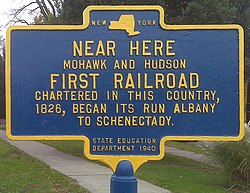This article includes a list of general references, but it lacks sufficient corresponding inline citations. (May 2013) |
The New York State Historic Marker program was an initiative to place historical markers around the New York State to commemorate sites of historical significance. The program was managed by the NYS Education Department from 1926 to 1966.[1]
 The Mohawk and Hudson Railroad, became the first railroad chartered in New York State this historic marker was donated by New York State Education Department in 1940. | |
| Established | 1923 |
|---|---|
| Location | New York, United States |
| Type | State/Private historic marker |
| Owner | Supported by the William G. Pomeroy Foundation |
| Website | www |
First created to commemorate the American Revolution, the markers were deemed a success. Although no longer funded by the state, markers are still being installed throughout New York State today by individuals, town and county governments, and historical organizations.
History
editThe State Historic Marker Program was started in 1926 by the New York State Education Department to acknowledge the Sesquicentennial (115 years) of the American Revolution. During the time of the program (1926–1939), over 2,800 small blue cast-iron site markers with yellow lettering were placed all over the state of New York. In 1939, funding for the program ceased.
During the 1960s, public funding was briefly granted again for larger, more detailed signs in places such as rest areas along the state's interstate highways and thruway. These large-format "Historic Area Markers" provided visitors with cultural information in a setting along routes with heavy traffic.[2]
The larger markers provide overviews of the history of New York, pointing out local significance that makes that particular place unique and interesting. In 1970, a booklet was released containing all the text of the rest area markers.
History of operations
editDuring the early period of the historic markers (1926–1939), the State Historian [SED] dispersed applications throughout the state to be reviewed and approved. The State then paid for the casting of the markers and planned their installation. Records of these markers were kept, and are available from the State Archives.
During the 1960s–1970s, installation of historic markers was encouraged at county and town level, SED approval was necessary. While during this time no state funding was available, private funds were forced to be raised. Signs were required to be cast at the Walton East Branch Foundry; this was the only place that had the molds for the markers already cast. The foundry required a letter from the state notifying them of the approval before production of the sign would begin. This insured no markers would be created without the States approval.
Throughout the 1980s, restrictions of the SED mandate cause the process to be revised. Today you must supply fact sheets to the field so that it may be entered into the data base of county listings of existing markers. Still today there is much interest in erecting new markers and replacing old ones. Grants such as those given out by the William G. Pomeroy Foundation provide funding for new markers.
The foundry supplies as many as 75–100 orders a year. Unless erected on state land permission to erect a marker is no longer required. Thus the current data base lacks some markers erected after the 1970s.
William G. Pomeroy Foundation
editThe William G. Pomeroy Foundation is private foundation that promotes the importance of local historic preservation and the roles markers play in all towns across the state of New York. These markers can provide much-needed economic assistance to small towns and villages where the markers are erected. As of 2024. the program recognizes historic people, places and things within 1740–1924 by providing grants to build new historic markers.
The Foundation unveiled its Historic Roadside Marker Program in 2006 to place markers in towns and villages within Onondaga County. In 2010, the program grew to other New York counties, including Cayuga County, Cortland County, Madison County, and Oswego County, as possible grant recipients. The next year the program expanded to include Erie County and Genesee County. In April 2012 the program began including all municipalities and not-for-profit organizations as eligible grant recipients. As of November 2024, the William G. Pomeroy Foundation reported funding over 1,100 historic markers all 62 New York counties.[2]
Today
editNew York Historic markers play a large role in educating the public as well as tourists of historic events. The William G. Pomeroy Foundation helps fund projects to continue to erect such markers. Currently there is no red tape or approval process for historic markers if placed on private land; although it is advised contacting a local historian before erecting such marker. When placing on state property there is an application process and you must have the text reviewed by the SED.
See also
editReferences
edit- ^ Lord, Philip, Jr. "Historical Markers: a Summary History". Office of State History. Retrieved 2024-11-15.
{{cite web}}: CS1 maint: multiple names: authors list (link) - ^ a b "New York State Historic Marker Grant Program". William G. Pomeroy Foundation. Retrieved 2024-11-15.
- "Outreach :: State Historic Markers". New York State Museum. Archived from the original on 2015-09-05. Retrieved 2013-04-21.
- Lord Jr., Philip. "Outreach :: State Historic Markers :: A Summary History". New York State Museum. Archived from the original on 2013-07-24. Retrieved 2013-04-21.
- "Preserving Heritage with Historic Markers". William G. Pomeroy Foundation. Archived from the original on 2013-05-10. Retrieved 2013-04-21.
- "Information about historical markers and historical plaques". Markeroni. Archived from the original on 2015-05-04. Retrieved 2013-04-21.
- "Outreach :: State Historic Markers :: How do I Get a New York State Historic Marker?". New York State Museum. Archived from the original on 2013-03-19. Retrieved 2013-04-21.
- "Historic Marker Database". New York State Museum. Archived from the original on 2013-03-24. Retrieved 2013-04-21.
- Cook, Breslin, Tom. "Piece of the Past". Retrieved May 1, 2013.
- "Catskill Casting Historical Markers". Catskill Casting. Retrieved May 1, 2013.